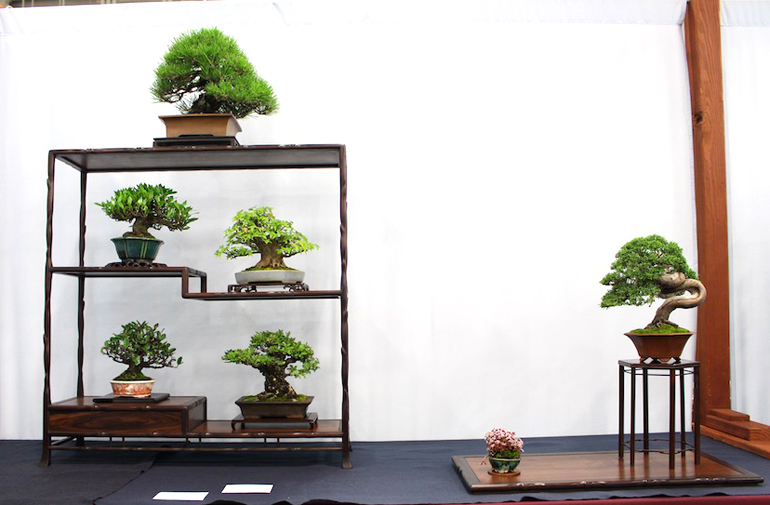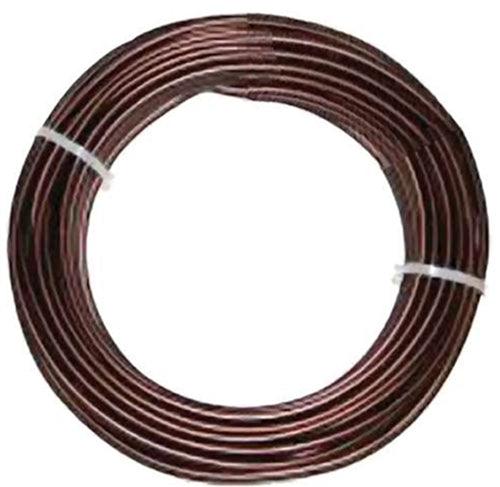Bonsai Tie Pots Are Back!

Our last shipment of Tie Pots sold out in two or three days.
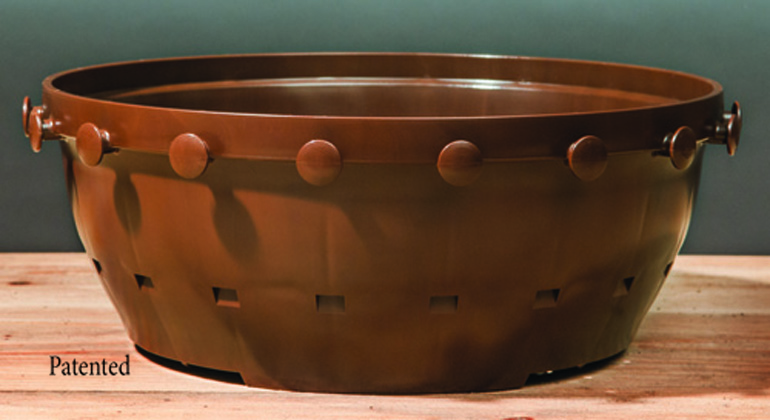
Tie Pots have the potential to revolutionize bonsai growing
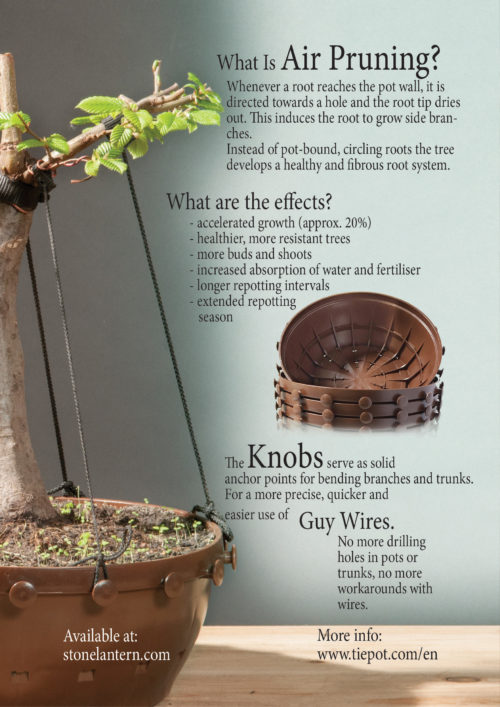
Two Exceptional Bonsai, Quick and Easy
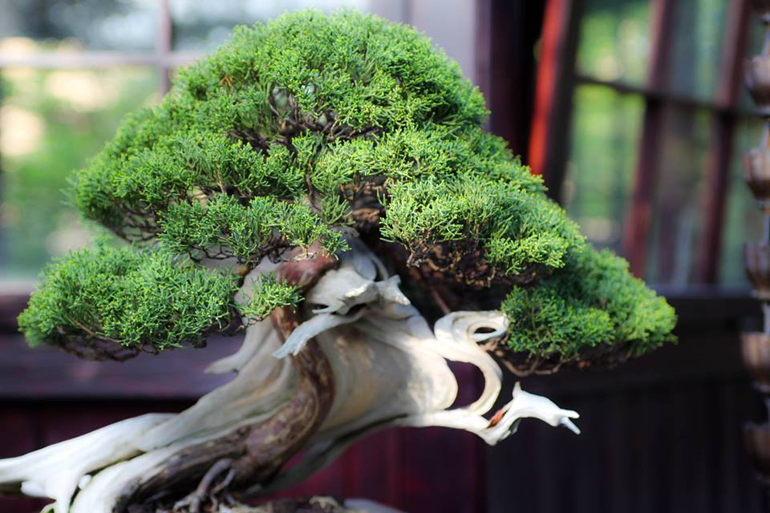
The pot is cut off, but this lush Shimpaku juniper with its strong shari and those expressive little jin, is okay without it... for the moment at least. This tree and the other shown here belong to Mariusz Folda. Mariusz' bonsai are becoming regulars on Bonsai Bark
I’m getting ready for a two week vacation today (I’ll still post when I get a chance), so we’ll revisit a good one that we posted May of last year. Just two trees with a close up of each. Both full sized photos are from Mariusz Folda’s facebook timeline. The cropping for the closeups was done by our crack Bonsai Bark staff (that’s me).
–

Continued from above…
The next two weeks is vacation time for two of us. For a company of three, this means our only staff will be Ric (I’ll try to keep up with emails). He’ll make sure orders keep flowing, but one person can only do so much, so we appreciate your patience

Mariusz doesn't say what this elegant twin trunk tree is
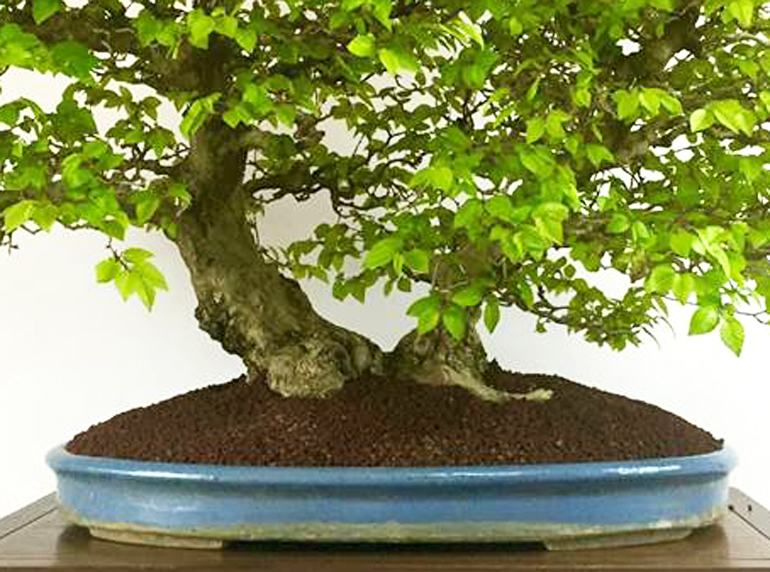
Hand Held Bonsai & a Glass of Good Red Wine
The leaves are very large in relation to the size of the tree, but this often happens with small bonsai and seems to work. At least in this case and many others I've seen. No variety is given, but clearly this is a Japanese maple. I cropped this photo and most of the others shown here for a closer look
I like good photos of hand held small bonsai. Mostly because it’s an aesthetically pleasing way to provide scale. A much better effect than a soft drink can (though Suthin’s glass of wine does the job without offending my sensibilities). I borrowed all but the last photo in this post from Hong Kong Bonsai Pots. No varieties or attribution is provided. I’ll give my guess on most of them, but remember they are just guesses. Feel free to offer corrections (it’s best to go to the comments on our fb timeline though if that doesn’t work, you can email me at wayne@stonelantern.com)
–

A red leaf Japanese maple. I won't guess the variety

Clearly a pine. Again, I won't guess the variety

Look like a Needle juniper (J rigida), but don't take it to the bank. My guesses can be a little shaky

Your guess is as good as mine
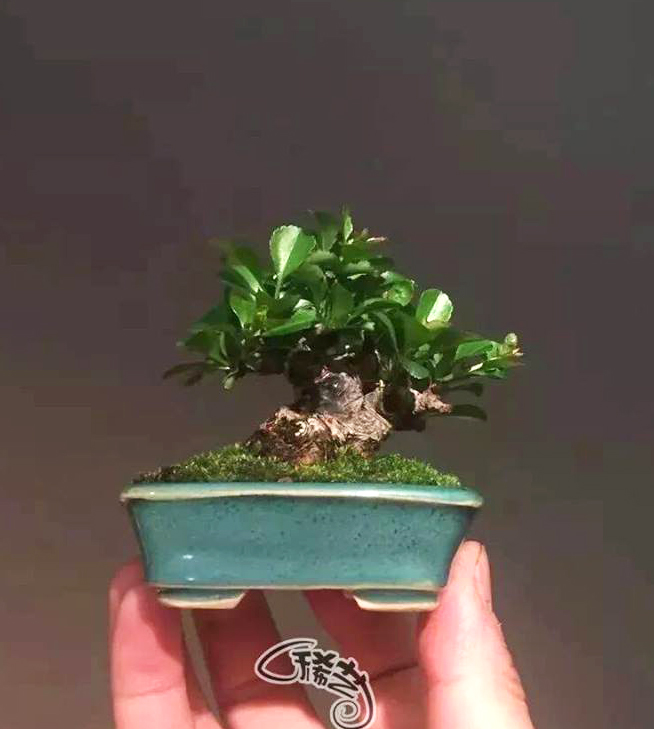
The leaves look familiar. Perhaps it's an Ilex. Going further out on a limb, perhaps it's a Japanese winterberry (Ilex crenata)?
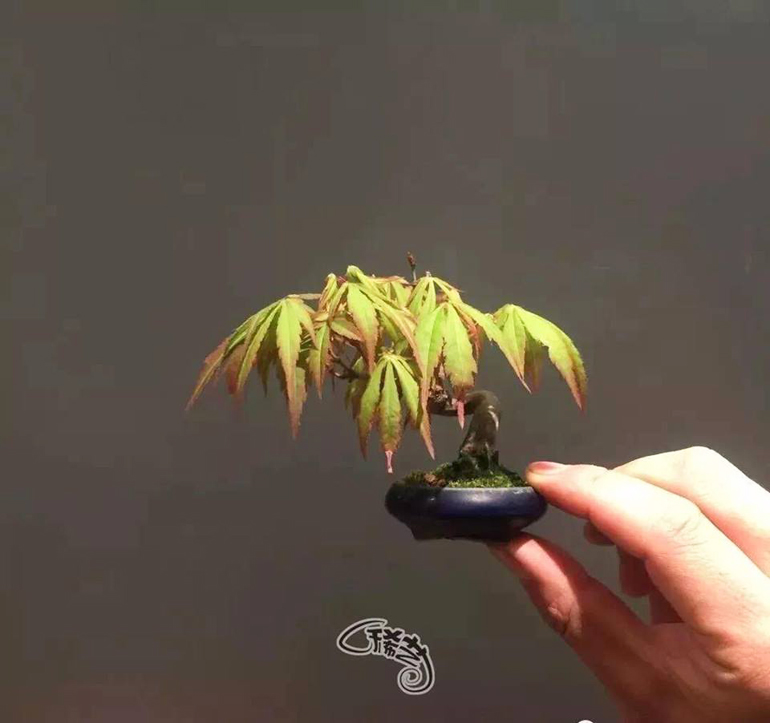
The uncropped original. All of the original photos have the little logo you see here. It's not Hong Kong Bonsai Pot's logo. Beyond that, your guess is as good as mine

Suthin's wine (btw, this photo has nothing to do with HK Bonsai Pots)
One Trunk Dead, the Other Alive & the Importance of Identification

Pine with parallel slanting trunks that start as a single tree and split at the base. One trunk dead, the other alive. It caught my attention because it's a somewhat unusual slanting tree with the pot and the visual weight of the foliage balancing each other perfectly. This and the other photos shown here were posted by Scott Lee. The caption reads Back in the studio with Peter Tea and Bonsai Kazem #japaneseart
Sticking with Scott Lee (see yesterday’s post) we’ve got three photos that he posted on facebook recently. Unfortunately, none are identified. I’m not sure why so many people put up photos without mentioning the varieties. I can’t be the only one who wants to know what kind of tree it is…
–
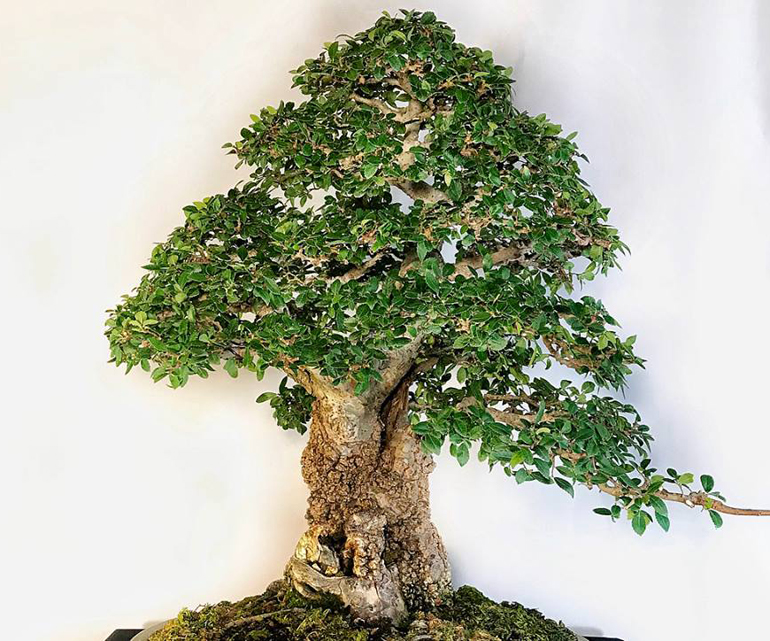
Again, no identification. I hope it's an olive because that's what it look like to me
Someone I respect recently suggested that I make more effort to identify the trees I post. I completely agree about the importance of identification and of attribution as well. However, researching can be time consuming and often doesn’t yield results anyway. If the tree belongs to me or if I know the variety, you’ll be the first to know. If everyone would do at least that much, especially if the tree belong to them, that would be a good start

Pine bark! Scott didn't mention the variety
Twisted – a Happy Accident
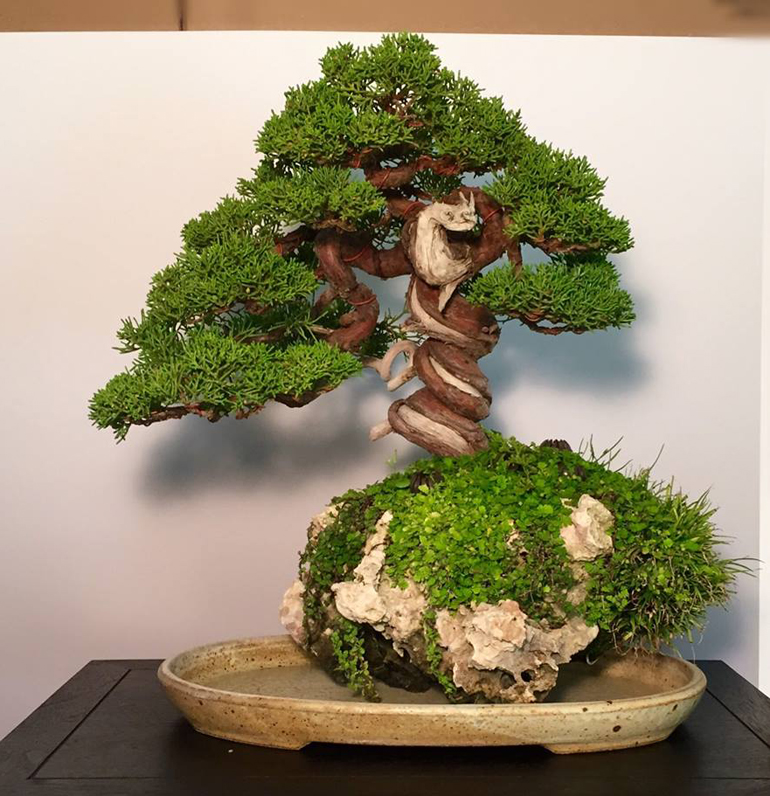
Here's what Scott Lee wrote about this tree... "A sad day for me. I had my bonsai selected for the 1st Artisans Cup in Portland, Oregon. This year the weather has been unpredictable and challenging for my area. The tree's health is not up to my standards nor Ryan's..." Continued below the next photo...
I just stumbled upon this unusual beauty in a post Scott Lee put up back in 2015. Purely a happy accident. The tree is a great example of an unconventional bonsai where little effort is made to make it naturalistic. Though there are plenty of twisted bonsai, especially yamadori from high elevations, I don’t think you’ll see any quite like this (not yamadori), with its uniform twists piled so neatly on top of each other. Anyway, I like it, and the Suthin connection doesn’t hurt either (see below).
–
Scott's original photo, with a particularly strong companion plant. No variety is given, though Scott does say the unusual pot is by Keith Kitoi and the little slab below is by Dave Lowman (see below for links)
Scott, continued from above… “Here is a peek of what I was going to show at the Portland Art Museum this month. Kishu shimpaku from Royal Bonsai Garden (Suthin), Sara Rayner suiban pottery, Jerry Braswell display stand, Keith Kitoi Taylor accent pottery and Dave Lowman display slab. An all American display. I want to thank everyone for there artistry in the American bonsai sceen. Good things are happening here, for that I am grateful.”
I cropped Scott's original photo for a closer look at the trunk
Another Impressive Before & After Bonsai Transformation

Though we often expect miracles when it comes to transforming mediocre or otherwise undeveloped bonsai into something as impressive as this one, in reality seven years strikes me as about right amount of time for such a radical transformation. The artist is Alfredo Salaccione and the tree is a Scots pine (Pinus sylvestris).
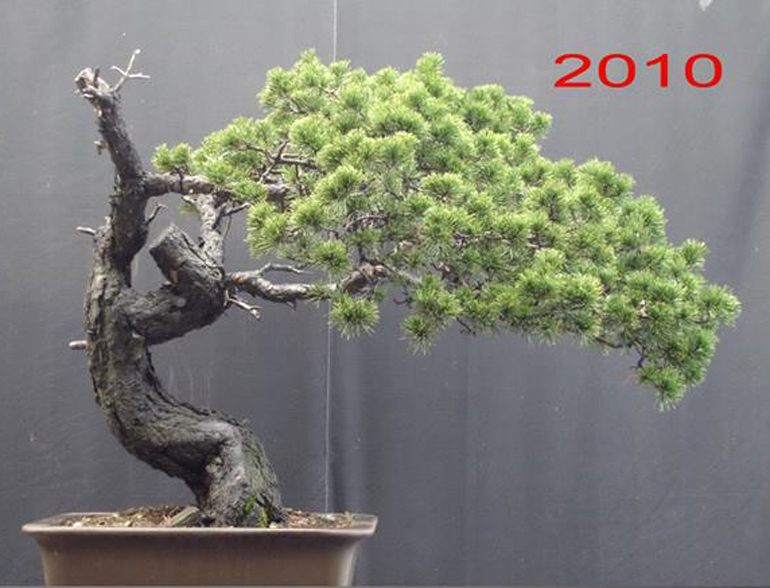
Before
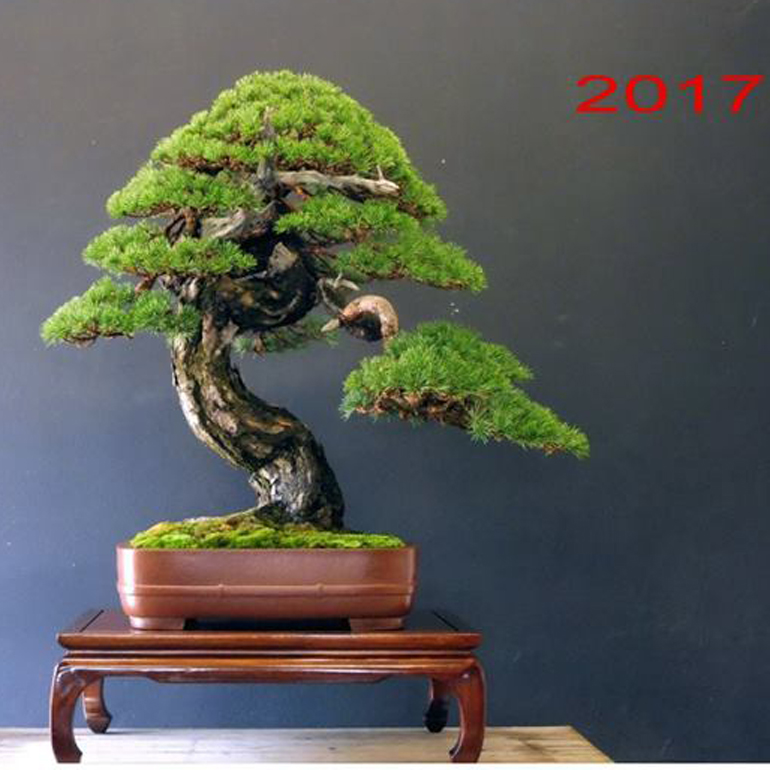
After. Seven years later

I cropped this one for a closer look at the trunk and deadwood

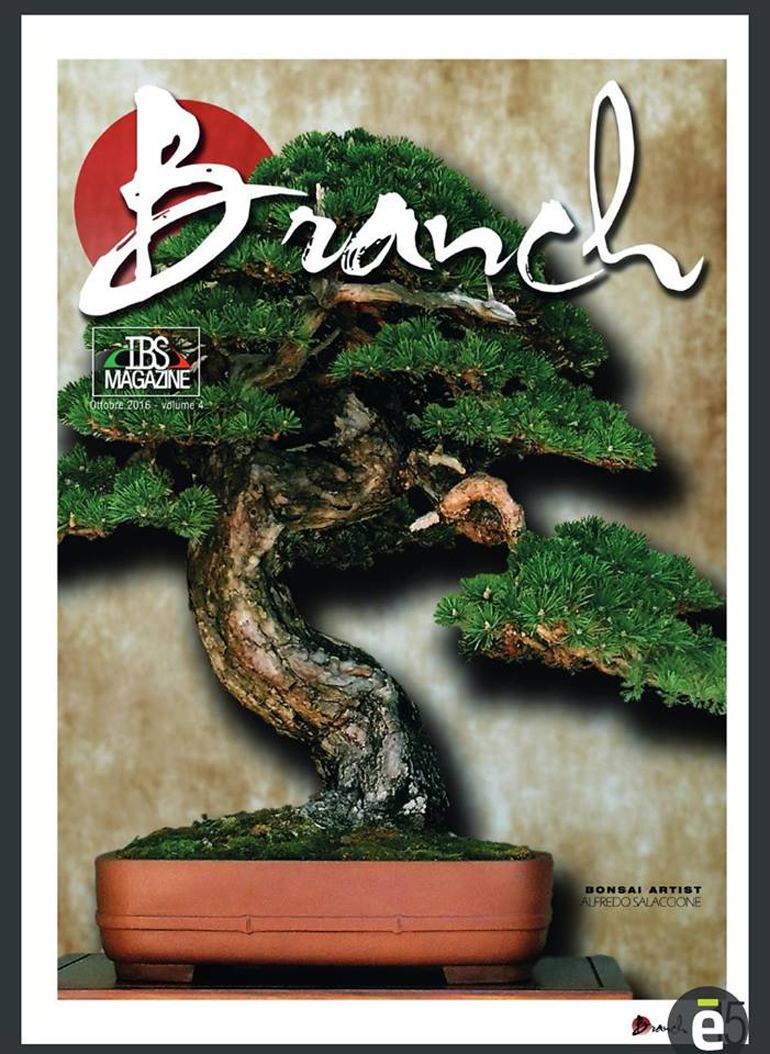
*I’m not sure why Alfredo chose Black Desire. You might expect a name like that on a one of the Black pines (Pinus nigra or Pinus thunbergii)
Deconstructing Nacho

Even though Nacho Marin doesn't mention the species, the origin of the crazy pot or give any indication of the tree's size, I couldn't resist. Here's Nacho's caption... "El estudio de la dinamica y el movimiento en el proceso de la deconstruccion de la imagen siempre arroja resultados impactantes." And here's my translation... "The study of the dynamics and movement in the process of deconstructing the image, always yields impressive results" All the images in this post are from Nacho's timeline
It has been awhile since we visited Nacho Marin, someone who was an accomplished artist before he started with bonsai. This might help explain his unusual approach. Most of us are influenced by the bonsai we see and study as we move along the bonsai path. This can be very helpful, but can also result in conformity rather than a more personal and daring approach. But maybe less so with Nacho, who brought an artist’s sensibilities from the beginning.
–
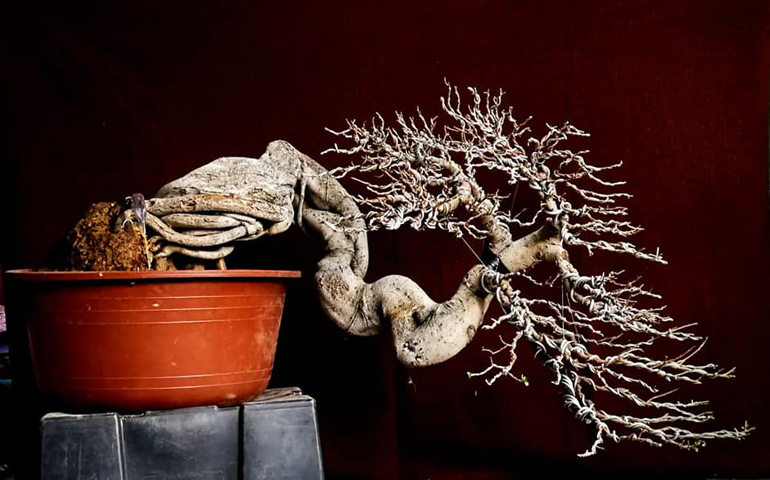
No species again, but at least we have some idea of the size of this one (see below)

Bigger than you thought? Nacho Marin the artist (on the left) with Ricardo Marin the owner. The caption says... "Nacho Marin Bonsai School....Guadalajara Mexico....9 2018." Nacho also has a Bonsai School in Bogata, Columbia
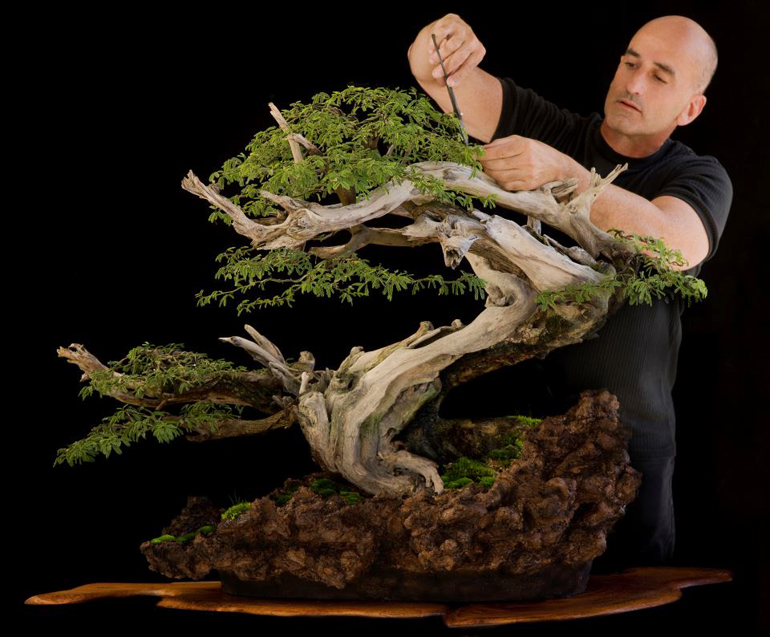
Nacho with an Acacia farnesiana
One More Time – A Spectacular Bonsai Event
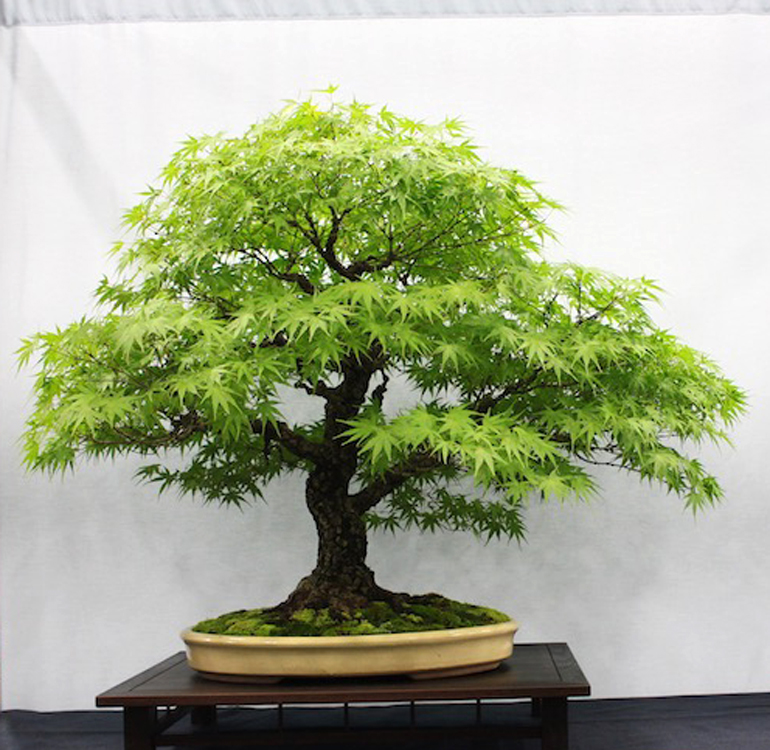
Kuhen Smith's Rough bark Japanese maple won the Finest Japanese Style Display at the 6th U.S. National Bonsai Exhibition. Unfortunately you can't make out the bark in this photo. No blame to Oscar Jonker, the photographer. The lighting in the display area was good for viewing but not necessarily for photos. I cropped Oscar original. The original is below
Today, it’s the final two prize winning bonsai at the 6th U.S. National Bonsai Exhibition. And some more photos by (or of) Candy Shirey. I hope you have enjoyed the series and maybe this will encourage you to make the trip to Rochester in 2020
Thanks to Bill Valavanis and his tireless Exhibition warriors for putting on a spectacular show. Thanks also to Oscar Jonker for his on the run shots of prize winners. And to Candy Shirey for her up close and personal shots of many of the good people involved in the Exhibition. And to everyone else who chipped in to make this the 6th U.S. National Bonsai Exhibition the best yet.
–
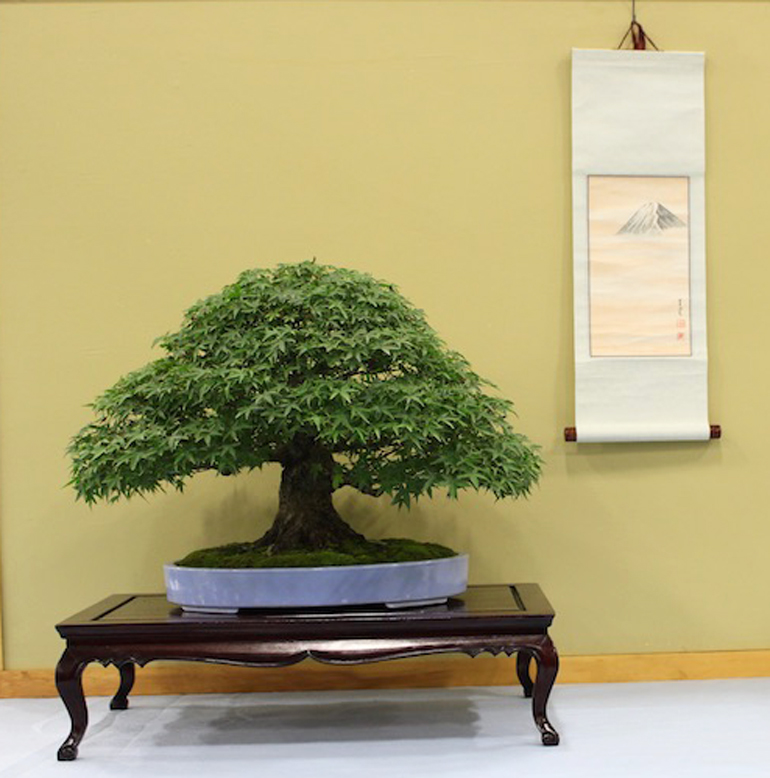
Brad Foresyth's Kiyo Hime Japanese maple won the Finest Classical Bonsai. Again, you can't really make out the details too well, even though I cropped the original for a closer look (especially at the trunk). Guess we'll have to wait for the album

Candy Shirey with her exhibited Hino Crimson Kanume Azalea. Candy is the source of numerous great photos from the exhibition. Including several that we've featured over the past week

Oscar's original shot of Kuhen's maple with companion and award certificate
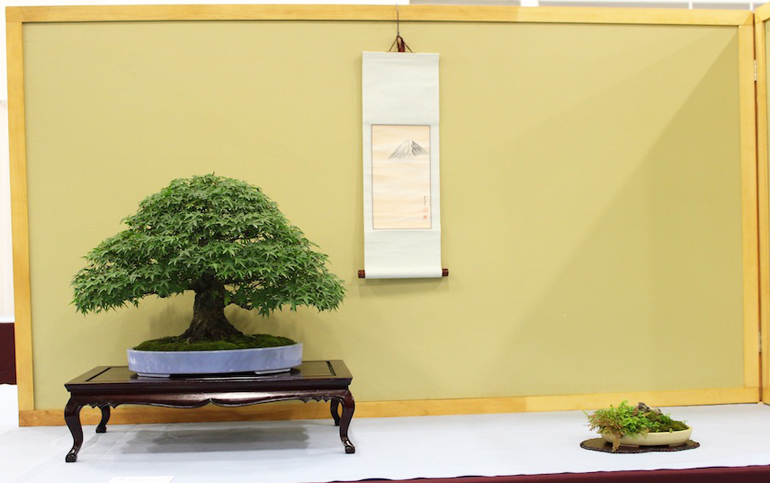
Original shot of Brad's Kiyo hime
Students of Kenji Miyata at the 6th US National Bonsai Exhibition. — with Marc Zimmerman, Linda Johnson, Anthony Alario, Candy Shirey and Brad Foresythe

I ran into David Knittle at the Exhibition and asked him how many of the exhibited trees were on his stands. Unfortunately, I don't remember his reply (CRS), but it was a very large number. And for good reason, David is a master craftsman. Here's some evidence, but it's only the tip. And btw David is a fellow Vermont resident. A special category of humans. Photo by Candy Shirey, of course
Natural Bonsai Winner

Mark Arpag's American larch won the All American Bonsai award at the 6th U.S. National Bonsai Exhibition. The rough hewn pot and stand (looks like a piece of wood), along with the wild ground cover, provide the perfect complement to the natural feel of the tree. I cropped Oscar Jonker's photo for closer look at the tree. The original photo is below
Just one tree today in our series on the prize winning bonsai at the 6th U.S. National Bonsai Exhibition. It’s a American larch (Larix laricina) and its natural untamed look strikes me as the right choice for this species. This might be because larches (Tamaracks in the local jargon) grow wild here in northern Vermont, so it’s a look those of us who live here are familiar with.
–
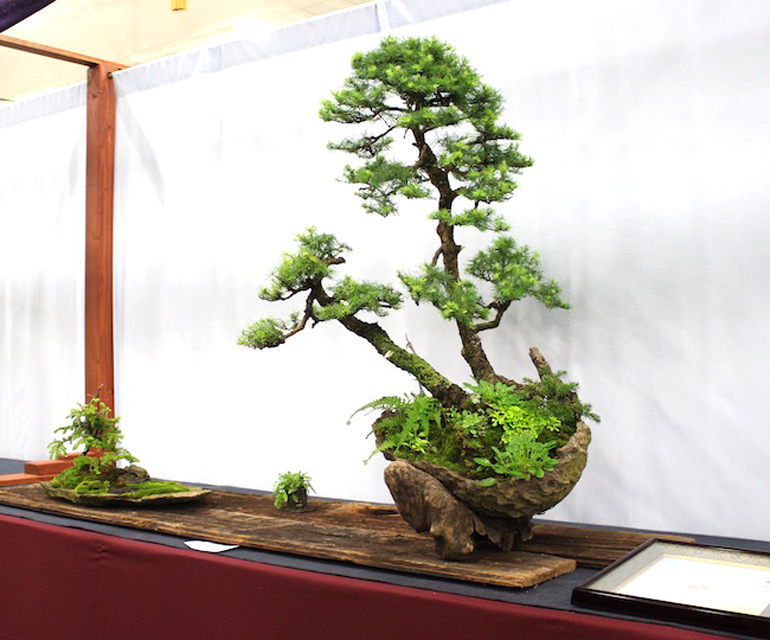
Oscar's original photo with two companions and a couple old boards that enhance the natural feel. I'm not sure what the tray on the right is about
Two More Award Winning Bonsai Favorites

I like the undulating parallel living veins on Jeremiah Lee's ABS award winning Sierra juniper (Juniperus occidentalis). I cropped the original (see below) for a closer look
Continuing with the prize winning bonsai from the 6th U.S. National Bonsai Exhibition, today we’ve got Oscar Jonker’s photos of the winning ABS Award Bonsai and the Finest Tropical Bonsai
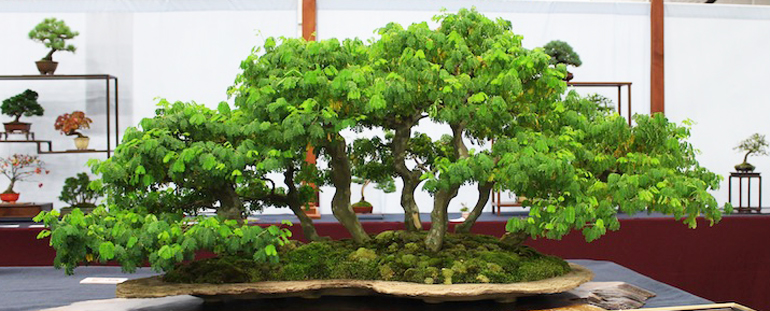
This one of my favorites. For starters its sheer size is a mind stopper. I don't know the dimensions and I know memory can play tricks, but I'll guess five feet across. But impressive size is only part of its power. Its vibrant color and health, the arrangement of the trunks, the massive slab and other tangibles and intangibles add up to an exceptional work of bonsai art. I wish you had been there to see it. Oh, and by the way, it's a Brazilian rain tree (Chloroleucon tortum, also known as Pithecellobium tortum) from the Sho Fu Bonsai Society of Sarasota, Florida that won the Finest Tropical Bonsai award. I cropped the original (just below)
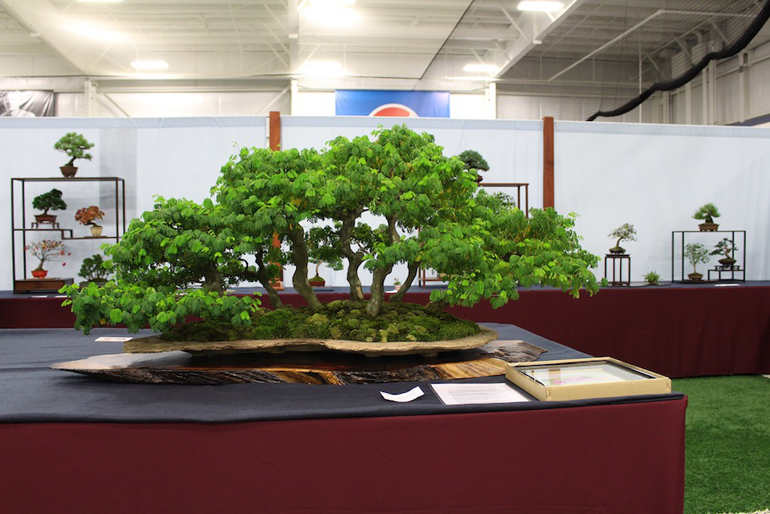
The original photo. Just getting rid of the top of the Pepsi sign is an improvement

Jeremiah Lee's Sierra juniper with companion
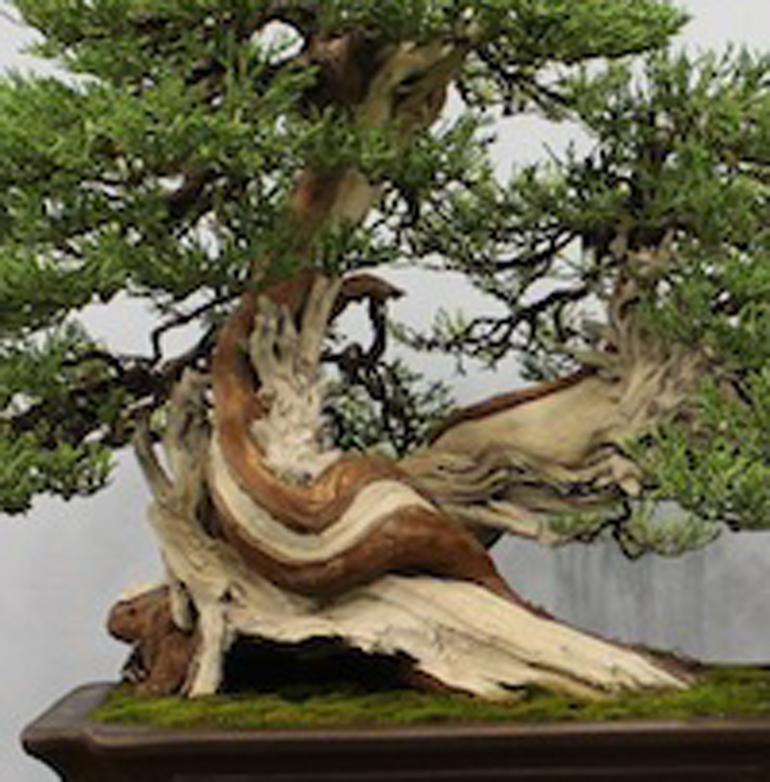
Apologies for the fuzz, but I wanted a closer look at the deadwood and living veins
Now, thanks to Alexander Hoffman, we have the names of the trees in John Kirby's Finest Shohin Bonsai Display from yesterday


